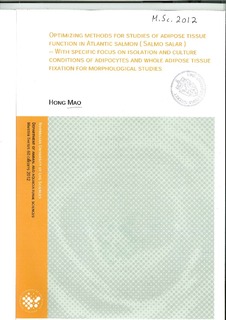| dc.description.abstract | Cell culture of adipocytes is a valuable research tool for studies of adipose tissue functions.
The first aim of this thesis was to optimize culture conditions for Atlantic salmon primary cells
derived from the adipose-derived stromal vascular fraction (aSVF).
Firstly, we have tested how different levels of fetal bovine serum (FBS) supplemented in the
media affect the development of adipocytes, from stem cells (pre-adipocytes), their
proliferation and further differentiation to mature adipocytes. Three levels (2.5%, 5% and 10%)
of FBS were studied. The result showed that 10% FBS significantly increased the proliferation
of pre-adipocytes, while the differentiation degree, was the highest with 5% of FBS. We also
tested the performance of cells in two different culture media. Our results suggested that
during the proliferation stage, Dulbecco’s modified Eagle’s medium (DMEM) medium with
CO2, improved the proliferation compared to the Leibowitz-15 (L-15) medium.
We, further, investigated the effects of two doses (0.1mM and 0.6mM) of docosahexaenoic
acid (22:6n-3, DHA) and oleic acid (18:1n-9, OA) on one important transcription factor
regulating the differentiation process, the CCAAT/enhancer binding protein alpha (C/EBPα)
and the expression of fatty acid transport protein (FATP) known to be highly expressed at late
differentiation stage. The expressions of both genes (the (C/EBPα) and (FATP) 1) were more
up-regulated with high dose of fatty acids (FAs) supplementation than with the low dose one,
showing that the FA level in the media influence the differentiation degree of adipocytes. More
and larger lipid droplets were formed in the cells supplemented with OA than those
supplemented with DHA, showing that also the type of FA differently influence the formation
of lipid droplets in adipocytes. Both OA and DHA induce the expression of C/EBPα and FATP
1 compared to the control group, however there was a more moderate lipid accumulation with
DHA than with OA.
ASVF includes cells of vasculature, immune cells, pre-adipocytes, mature adipocytes and stem cells. The standard protocol for isolation aSVF cells, removes the mature adipocytes and partly
digested tissue. However the cell fractions that are seeded on culture dishes contain adipose
cells of many different developmental stages and blood cells. In order to isolate a more pure
stem cell and pre-adipocyte fraction, one aim of this thesis was to establish a method for
purification of the target cells by Percoll density gradient centrifugation. Density formation
was tested by using 36% and 70% Percoll and centrifugation at 30 000g and 60 000g in our
study. The results showed that 36% Percoll centrifuged at 60 000g formed a gradient suitable
for further centrifugation and purification of stem cells. The verification of the identity of the
purified cells was done by gene expression analysis. The results showed that C/EBPα, C/EBPδ
and FATP 1 were significantly lower expressed in the isolated stem cells compared to mature
adipocytes, while C/EBPβ was higher expressed in mature adipocytes. That implied that the
isolated cells were still in an early developmental stage, and they remain viability after the
isolation and recover successfully during the cultivation and have high capacity to proliferate.
However, we cannot distinguish between stem cells and pre-adipocytes, except based on their
differences in gene expression.
CryoWax method was tested for its feasibility in adipose tissue in our laboratory mainly for
the purpose of morphological preservation. The process was carried out by freeze substitution
and polyester wax embedding procedure. The fine structure and antigenicity of the tissue were
well preserved after the above procedure. However, lipids were not well preserved in this high
lipid content tissue. Our results indicate a need for further improvement of the method in order
to conserve the lipids inside adipose tissue. | no_NO |
